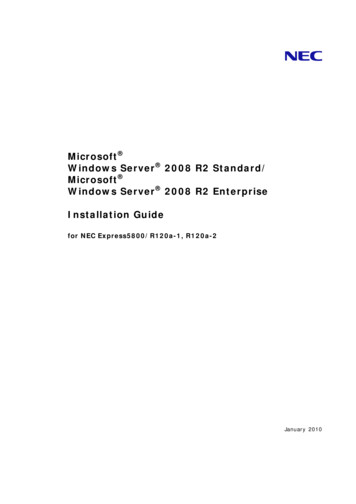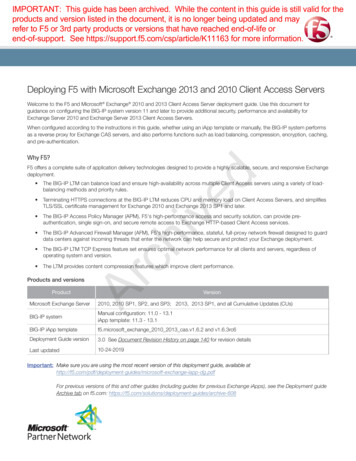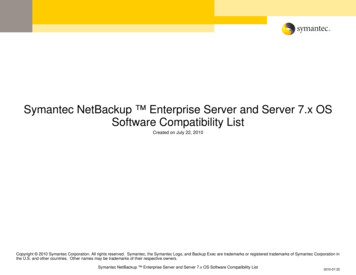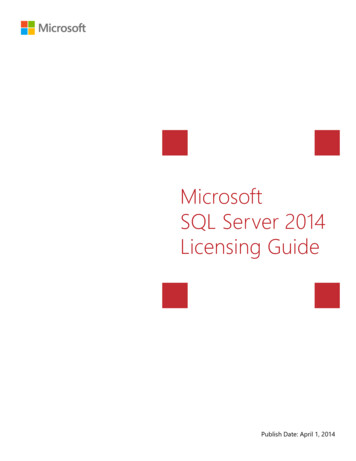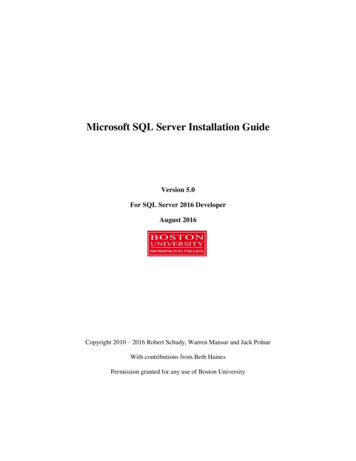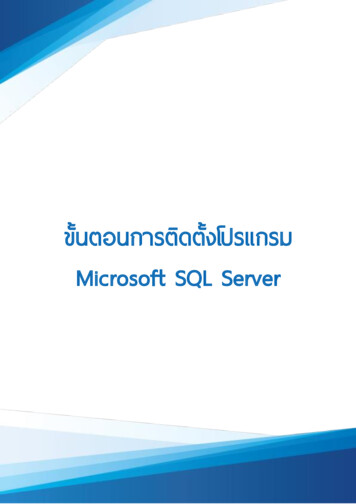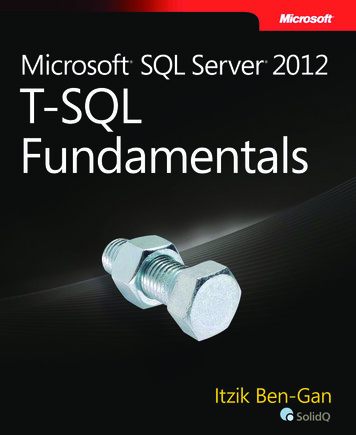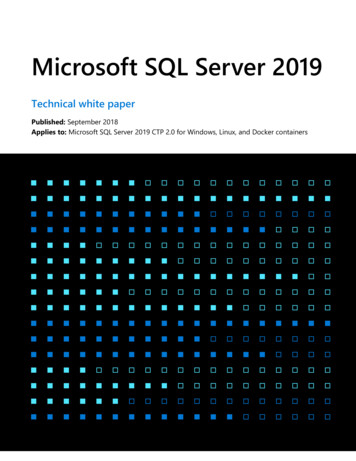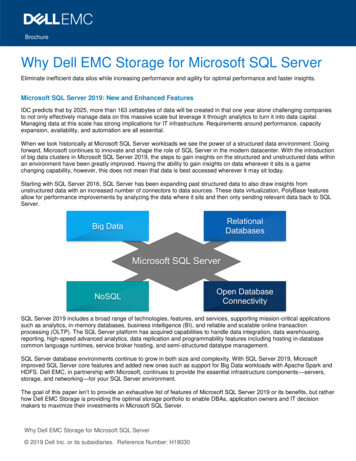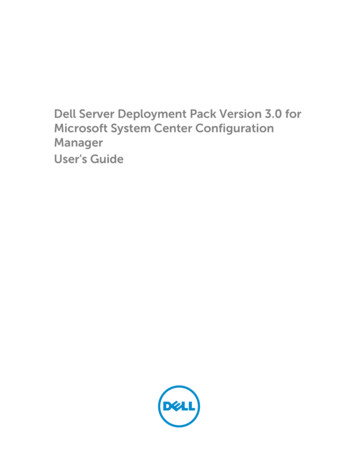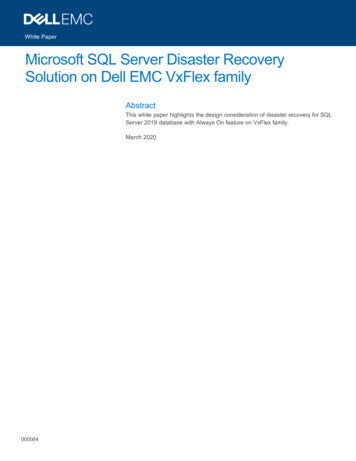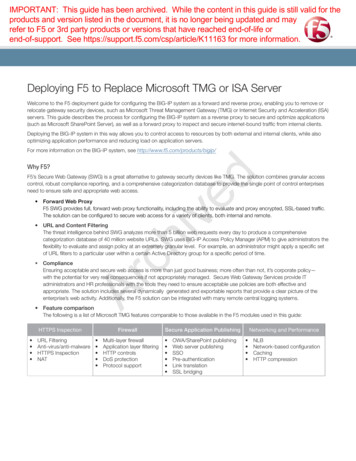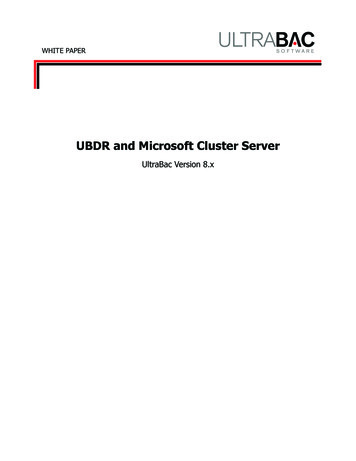
Transcription
WHITE PAPERUBDR and Microsoft Cluster ServerUltraBac Version 8.x
UltraBac SoftwareOVERVIEWUltraBac Software, author of award-winning backup and storage management software, isproud to announce enhanced support for Microsoft Cluster Server. The company’s software hassupported cluster servers since 1999 with its version 5 release, and continues to do so today withits most recent version 8. UltraBac fully supports all Windows 2000/2003 environments.While clustered environments are designed to provide high availability to users who buythis technology, a strong disaster recovery plan is still required because a node can fail. Thisleaves the cluster vulnerable to a total failure until the failed node has been restored to 100%operational status — this is particularly true in a two node cluster. Therefore, a comprehensivedisaster recovery plan must not only include a quick recovery of the node and its data, but shouldalso require saving multiple backup copies that are rotated and saved off-site.UltraBac Software’s UltraBac Disaster Recovery (UBDR) Gold product has been designed toquickly and easily restore a failed node to 100 percent operational status after suffering acatastrophic or unbootable server failure. Microsoft Cluster Server 2003 customers (and manyothers) require the highest availability possible for their critical servers and applications. Dueto this requirement, image based disaster recovery software, like UBDR Gold, is the cornerstone of any comprehensive disaster recovery plan. Because until a machine can be restored to100 percent operational status, any further required disaster recovery operation is at a completestandstill.Using cutting edge “snapshot” technology, UBDR Gold backs up the file system within apartition, disk, or all disks connected to a machine. All open files are backed up, includingrelational databases that might be operating split over multiple partitions or disks. Being able tosafely and concurrently “lock” all open files during the snapshot process guaranties the integrityof every backup. In turn, this equates to being able to securely restore any required partition withthe assurance that all of its files and databases have been absolutely preserved. For cluster serverusers, this includes the operating system partition, the cluster quorum database partition, and anyother data or shared drives that might be active on a node at the time of backup.Figure 1: The following diagram shows a basic server cluster configuration. Each server node has a local disk which cancontain information specific to the node.In the event of an unbootable failure, a recovery can be initiated by a quick boot off the WinPEUBDR and Microsoft Cluster Server2
UltraBac Softwarebased UBDR CD. There is no need to install a temporary operating system (OS) as with atraditional file based recovery. An operator only needs to follow the simple steps providedby the restore wizard to recover a failed node’s OS partition to the last point-in-time snapshot(image backup). Then, if needed, an operator can restore any other partition(s) on any othervirtual network names. For cluster server users, a disaster recovery operation properly restoresall the cluster node information captured during the image backup. Therefore, a recoveryspecifically includes restoring a node’s Disk Signatures, GUIDs, and SIDs to ensure that arecovered clustered machine boots successfully with no errors.HISTORYUltraBac was the first commercial software product to introduce image backup with flexibleoptions. This included the ability to back up any network resource that Windows couldconnect to via a UNC share path. Furthermore, UltraBac Software was also the first company toconclusively prove that a third party backup program could successfully back up and restore anactive, online Windows Cluster Server configured with multiple nodes. In this test, the backedup cluster node was actively running SQL Server. The recovery trial was set up and monitoredby Microsoft personnel at their Partner Solution Center on Microsoft’s main campus located inRedmond, Washington.UltraBac was installed on a networked server, and performed a backup of one of the two activecluster nodes to a stand alone tape drive. Options for backup other than local tape include: localdisk, remote disk, remote tape, local libraries, remote libraries, SAN/NAS devices, TSM servers,FTP devices, CD/DVD writers, optical, and networked UNC paths. Image backups can also bewritten to any hardware based RAID device (including RAID 5).After erasing the test cluster node’s OS partition using FDISK, UBDR was used to boot the failedcluster and rapidly restored the server, without any complications, in approximately eightminutes. The restore included a 100% retrieval of the failed cluster node’s registry. Uponrecovery, the failed cluster node was re-synchronized successfully to resume 100% clusteroperation. No intermediary software or steps were required – just basically boot, restore andreboot. UltraBac Software customers have reported speeds from 1-3GB/minute when performingnetwork and local tape restores. Network restore performance is highly dependent on connectionspeed, network traffic, and machine configuration.Figure 2: Steps to recover a single cluster node.UBDR and Microsoft Cluster Server3
UltraBac SoftwareTODAYSince UltraBac’s debut as the first commercial backup application to successfully back up andrestore an active Microsoft Cluster Server, support has been continually added for every newserver operating system since NT 4.0. With Windows 2003, users now have the choice of usingeither Microsoft’s Volume Shadow Copy Service (VSS) or UltraBac Software’s built-in LockedFile Backup (LFB) Agent for selected partition(s) or full disk backups. Microsoft’s VSS does notcurrently support incremental or differential image backups for Windows 2003 so, when thesetypes of backups are required, the software automatically uses UltraBac’s built-in LFB Agentto safely back up all open files. For file based and image backups, UltraBac can freeze all openfiles on a single disk, or on all disks physically connected to a machine. This eliminates anyrequirement to boot a machine into a “safe-mode” for backup as do some competitive productson the market. Literally just point and click for a perfect snapshot on an active 24x7 machineat any time. With UltraBac, an average 8GB OS partition is backed up on a typical 100BaseTnetwork connection at approximately 1GB/minute. Gigabit connections offer backup speeds ofup to 3GB/minute when run during a period of low network activity.Today, UltraBac customers have many powerful new features including two WinPE CD basedversions of UBDR. Using WinPE provides customers with a “universal” boot CD that comespre-installed with every current device driver required to boot any Wintel machine. Whenbooting from the CD, drivers are automatically installed for every required NIC, SCSI, and/orRAID controller — the days of having to create special pre-configuring boot media for eachmachine, or unique hardware configuration, are long gone! The Windows based wizard thenguides the user through a complete recovery in a matter of minutes.UltraBac Software now provides the GUI based versions of UBDR Pro and UBDR Gold asopposed to the text based DOS version used at the 1999 Microsoft test. UBDR Gold offers allthe functionality of Pro, but adds the newly released support for true dissimilar hardware restore,virtual integration to both VMware ESX/GSX and Microsoft Virtual Server 2005, physical-tovirtual (P2V) restore, virtual-to-virtual (V2V) restore, and virtual-to-physical (V2P) restore.Gold also offers the ability to cold boot an image backup, cold boot a file based backup, coldboot a file based restore, and perform 100% scripted restores for no user intervention. UBDRGold also offers optional cost agents for local and remote autoloader support, TSM support, andFTP support.SMART IMAGE TECHNOLOGYBasic UBDR Pro functionality includes smart image technology whereby the default option is toonly back up actively marked in-use disk clusters. Furthermore, large files on OS partitions, liketemporary page files and hibernation files, are automatically skipped because they cannot be reused after a restore, and therefore would be a waste of both time and space to back up. The diskblocks that are backed up are automatically compressed before being written to the backup targetlocation. The idea behind “smart” image technology is to back up only the absolute minimumnecessary during a block level backup of a partition or disk.ENCRYPTIONUBDR provides a built-in encryption option with up to 128-bit data protection. When invokedduring a backup, each block is encrypted during the process of reading the data for writing toUBDR and Microsoft Cluster Server4
UltraBac Softwarethe backup device. This means that whether the backup “pushes” or “pulls” the images across anetwork, they are guaranteed to be 100% secure.SPEEDImage backup and restores can provide performance speed at or near manufacturer device ratesbecause the technology bypasses the OS and does direct reads and writes to disk. While thisallows backups to run faster on an active system, it significantly increases disaster recoveryrestore speeds because UBDR does not have to negotiate with an active OS partition during arecovery.SINGLE FILE RESTOREAdministrators can optionally enable UltraBac’s Single File Restore (SFR) for backups. WithSFR enabled, each backup automatically creates an additional index which allows individual filesand/or folders to be restored from a saved image backup.DISK-TO-DISK-TO-TAPECustomers performing image backups to online network locations also have the option to useUltraCopy. UltraCopy is an optional utility that provides the ability to copy or move online diskbackups to tape. Clients performing multiple concurrent “push” image backups can useUltraCopy to copy, or move, all separate backups to tape with a consolidated index written to themedia. For example, UltraCopy could be used if a client had 30 licensed copies of stand aloneUBDR installed on its network servers that were individually scheduled to back up to a centralRAID5 storage device. Using UltraCopy, they would script a disk-to-tape backup of all 30 diskbackups to a tape drive with a new and comprehensive index written to the media, enablingdirect retrievals from each UltraCopy created tape. Tape-to-tape copying is also supported.UltraCopy essentially provides a two stage disk-to-disk-to-tape operation (autoloaders notcurrently supported).FLEXIBILITYUBDR Pro and Gold support basic disk with both primary and extended (logical) partitions,EISA partitions, Dynamic disks (both simple and mirrored volumes), and Basic and DynamicGPT disks. Both products are also available in true 64-bit versions. They natively support bothIntel Itanium 64-bit and AMD x64 processors.CUSTOMERSUsers of bare metal disaster recovery software all have a common profile regardless of theirbusiness orientation or size. All Windows based machines have an innate liability for loss ofproductivity due to unbootable failures. This is because Windows only supports one bootableoperating system partition. While downtime from hardware failures can be minimized byimplementation of RAID, disk mirroring, Cluster Servers, continuous data protection, and filebased backup software, none of these solutions provide the ability to quickly and painlesslyrecover a failed machine that cannot be booted. Statistics indicate that approximately 65% ofunbootable failures are software based. This means a corrupted registry, a bad device driver, adeleted file, a virus, a Trojan, or perhaps some other problem accidentally caused by an operatorwas the root cause of the failure. The problem with every other protection scheme is that noneof them provide the ability to quickly restore a failed machine’s operating system! ConsiderUBDR and Microsoft Cluster Server5
UltraBac Softwaremirroring or CDP, both simply copy corruption, virus, or any other “soft” problem. Usingnormal Windows recovery techniques, restoring an unbootable machine takes anywhere from acouple of hours to a couple of days. With the cost of downtime ranging from 5,000 an hour formodest servers to easily over 100,000 an hour for critical servers, it does not take amathematician to calculate that restoring a failed server in 10-30 minutes is going to save anorganization money. It might even save the business from a total financial catastrophe.Customers of UltraBac Software’s UBDR Pro and Gold include some of the world’s largestcorporations and government entities. These organizations are using thousands of licenses toprotect every server in their network. Other customers include many of the world’s smallestcompanies and organizations. A common denominator among these different sized organizationsare that often they have limited or no technical staff. UBDR is basically disaster recoveryinsurance that offers customers a means to recover a failed server quickly and easily, even whenno technical staff is available. Recoveries can be fully scripted for totally automated restores,and can even be performed remotely on PXE enabled machines.SUMMARYWith UltraBac Software, customers have the widest range of backup and disaster recoveryoptions available in the Windows market. Whether a customer wants to use UBDR on a standalone server, or requires a full backup and disaster recovery solution that integrates both fileand image backups into a single job, UltraBac offers the flexibility of either role in your disasterrecovery plan.Customers with existing backup solutions in place can easily integrate UBDR’s bare metaldisaster functionality to further enhance and add to their disaster recovery preparedness.UBDR’s coexistence capability is especially appreciated by larger scale enterprise customerswho have found that UBDR runs without conflict with existing applications.The foundation for every disaster recovery plan should be the implementation of a bare metaldisaster recovery product like UltraBac Software’s UBDR Pro and Gold. Bare metaldisaster recovery should be the primary recovery tool in any data protection plan for criticalWintel machines, including Microsoft Cluster Servers (since a two cluster node is extremelyvulnerable after one node fails). UltraBac bare metal disaster recovery software was designedfor users who consider their servers to be mission critical and require the highest availabilitypossible.UBDR is easy to operate and deploy within any size network. The built-in scheduler and“locked open file” backup technology allows organizations (from the smallest of businesses tohuge data centers) that rely on Windows to automate their backup jobs, and image liveproduction machines quickly, and without conflict. Once installed and operational, UBDRprovides customers a fast and painless means of restoring a failed machine to full operationalstatus.In summary, UBDR Gold allows the recovery of a failed operating system partition, on anunbootable machine, in a fraction of the time it normally takes to do the same using traditionalrecovery methods. This saves not only a considerable amount of time and effort, but also a lot ofUBDR and Microsoft Cluster Server6
UltraBac Softwaremoney whether the recovery is performed on a Microsoft Small Business Server or a powerfulfour-node cluster server. Few applications offer a 100 percent return on investment from a singleuse as does UltraBac Software’s UBDR Gold image based disaster recovery. Copyright 2006 UltraBac Software. All rights reserved.UltraBac Software believes the information in this publication is accurate as of its publication date. The information is subject tochange without notice.UltraBac Software, UltraBac, UBDR Pro, UBDR Gold, UltraBac Software logo, and Backup and Disaster Recovery for Business aretrademarks of UltraBac Software. Other product names mentioned herein may be trademarked and are property of their respectivecompanies.
UltraBac was installed on a networked server, and performed a backup of one of the two active cluster nodes to a stand alone tape drive. Options for backup other than local tape include: local disk, remote disk, remote tape, local libraries, remote
